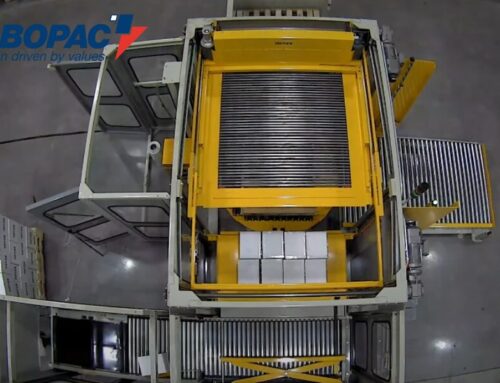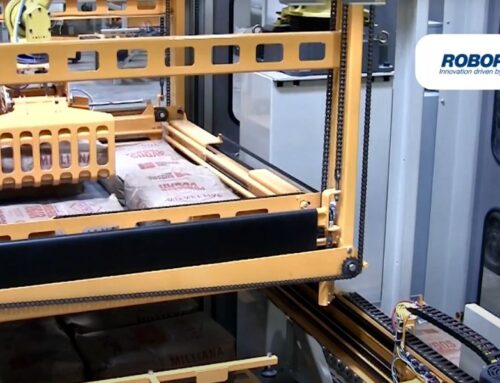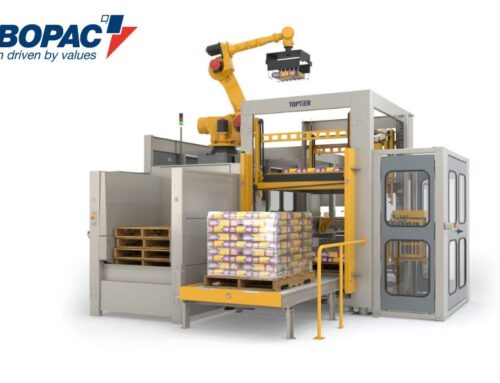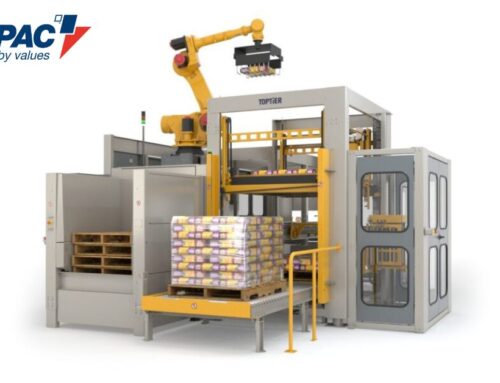In an era where efficiency and speed are paramount, palletizers have become indispensable tools in industries like manufacturing, logistics, and warehousing. These machines play a pivotal role in streamlining operations and reducing the need for manual labor, which not only enhances productivity but also ensures safer working environments.
Understanding what palletizers are and how they work helps business owners invest in the best equipment to boost efficiency, consistency, and safety for their operations. Learn more about the different types of palletizers and how they can impact workflow with this overview.
Introduction to Palletizers
Palletizers are machines designed to automatically stack products onto pallets in a precise and efficient manner. They have revolutionized the way businesses handle packaging, ensuring that products are stacked neatly and securely before moving on to transportation or storage.
The primary purpose of palletizers is to save time and reduce the physical strain on workers, enabling companies to meet high production demands without compromising on safety or quality. From small businesses to large manufacturing plants, palletizers can help any operation optimize workflow and improve overall efficiency.
How Palletizers Work
The operation of a palletizer begins with the loading of products onto a conveyor system, which transports them to the palletizing station. At this stage, the machine arranges the products according to a predetermined pattern, ensuring optimal stacking stability and efficiency.
After arranging the products properly, the palletizer lifts them and places them onto a pallet. This process is repeated until the pallet is fully loaded and ready to move on to the next stage in the packaging line. The automation of these processes not only speeds up production but also minimizes human error, leading to more consistent and reliable packaging.
Key Benefits of Automatic Palletizing Systems
Automatic palletizing systems bring a multitude of advantages to businesses. They ensure consistent and precise product stacking, reducing the risk of damage during transportation. This consistency is crucial for maintaining product quality and customer satisfaction. Additionally, these systems can handle high volumes of products quickly and accurately, which is essential for businesses looking to scale their operations.
Another significant benefit is the reduction in manual labor. Automatic palletizing systems take over repetitive tasks, freeing up employees to focus on more strategic and value-added activities. This shift not only boosts overall productivity but also enhances employee job satisfaction, as they are no longer burdened with monotonous tasks. Furthermore, automatic palletizers reduce physically strenuous activity. By eliminating the bending, lifting, and other physical labor aspects of manual palletizing, businesses can prevent employee injuries and maintain a safer, healthier workforce.
Finally, automatic palletizing systems are highly adaptable. Businesses can program their palletizers to handle various types of products and packaging configurations, making them suitable for a wide range of industries. This flexibility ensures that businesses can adapt to changing market demands without the need for significant reconfiguration or investment in new equipment.
Types of Palletizers
When it comes to palletizers, one size does not fit all. There are various types of palletizers, each designed to meet specific needs and applications. When choosing an automatic palletizing system for a business, it’s crucial to consider production volume, space limitations, and other needs. These factors help businesses compare their options to make informed decisions for their particular workflows.
Pick N Place Model
Robopac USA’s Pick N Place palletizer is a compact system that offers the power of an automatic palletizer in the smallest possible footprint. This system is a great space saver for operations working with tighter floor layouts. It has the versatility to suit a wide variety of product types and can handle up to 12 cases per minute, making it ideal for any low-volume product line.
Low Infeed Conventional
Low infeed palletizers feature floor-level conveyor feeds, making it easy to integrate with existing packaging lines. Products move from the conveyor into the machine, which intuitively orients, aligns, and stacks products to create secure pallet loads.
Low level infeed palletizers offer seamless integration with existing operations. They’re capable of palletizing one to three layers per minute and can handle many different product types, including case, tray, trayless, open top, lidded, overwrapped or unwrapped, and more.
High Infeed Conventional
For a high-speed conventional palletizing solution, a high infeed palletizer is the right choice. High infeed palletizers operate similarly to the low infeed option, but with a higher conveyor feed and faster, more powerful lifting and lowering technology. The result is a fast and accurate solution for stacking products securely and efficiently, building up to four layers per minute.
Robotic Palletizer
Robotic palletizer systems feature a robotic arm that grabs and maneuvers products to build pallet loads—this allows for a superior level of precision and versatility. Robotic palletizers can build up to three layers per minute. They can also handle every product type, delivering control, flexibility, precision, and efficiency to any packaging line.
Hybrid Robotic Palletizer
Hybrid palletizer systems combine the speed of a conventional palletizer with the precision of a robotic palletizer. Our RoboTier hybrid robotic palletizer can handle every product type and builds up to three layers per minute, delivering stable, precise, and efficient product loads.
Considerations for Implementing Palletizers
Deciding to implement a palletizer involves several considerations. Space requirements are a crucial factor, as these machines vary in size and configuration. Businesses must ensure they have adequate floor space to accommodate their chosen palletizers, along with sufficient room for operation and maintenance.
Production needs also play a significant role in the selection process. Companies must assess their production volumes and the types of products they handle to determine the most suitable palletizers. For instance, a business with high output and diverse product lines may benefit from a robotic palletizer’s flexibility, while a smaller operation might find a low-level palletizer more appropriate.
Budget constraints are another important consideration. While palletizers are a significant investment, the long-term benefits in terms of increased efficiency, reduced labor costs, and improved safety often justify the expenditure. It is essential to evaluate the return on investment (ROI) and choose a palletizer that aligns with the company’s financial capabilities and operational goals.
Robopac USA offers a versatile selection of palletizing equipment to help revolutionize your packaging line. Learn more about our palletizers and how they work and find the machine that will take your workflow to the next level when you visit us today.








